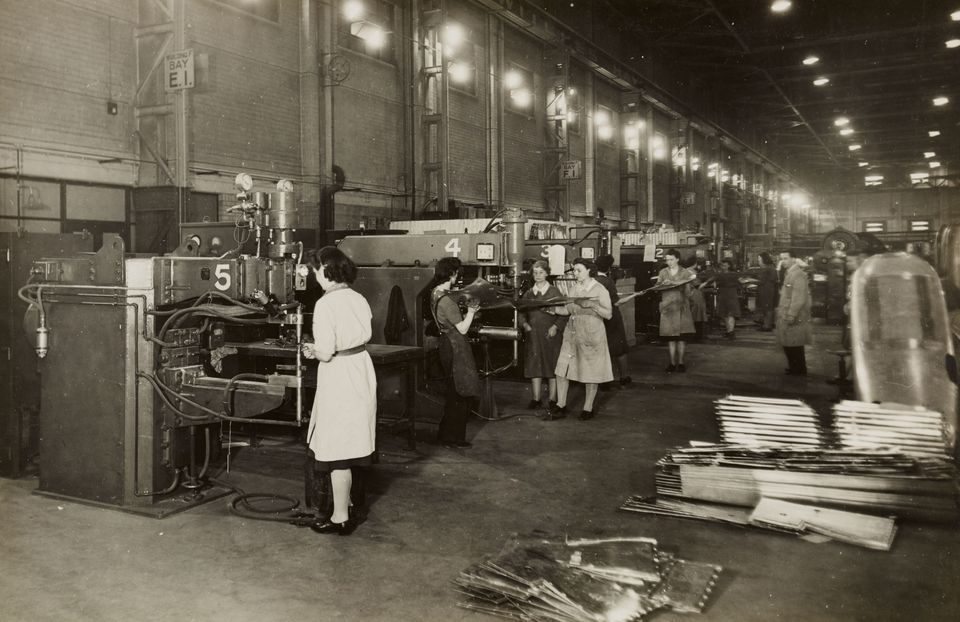Where did the firm come from?

Economics is a curious social science. As I read more about economic theory, I frequently find the existence of agents or relations is often assumed to be in a particular form without explanation for how we arrived there (perhaps I have not read sufficient economic history). Two of the questions that have always intrigued me in this regard are about the nature of the producing firm: why does it exist in this form? how does it actually act?
There is an institutional history to the firm. We didn’t have “firms”, as we typically conceive of them today, in the Middle Ages. Instead there were craftsmen and guilds. The theory of the firm is an umbrella for multiple different theories of why firms exist, where their boundaries are, how they are organized, and how they behave.
In economics it is typically assumed the firm exists with a particular set of attributes: Its aim is to maximize profits. It hires labour and capital and produces goods with them using a production function, a bouillabaisse-type recipe where all production factors are inputs to the function and output appears (all in dollar terms). The firm's decision is primarily how much to produce and what price to charge. This does leave out a lot of other firm activities.
I recently joined a Twitter space with Nathan Tankus (definitely check him out), which led to a great conversation on heterodox economics. In pursuit of more reading, I went down a rabbit hole on the internet that led me to the work of Axel Leijonhufvud (I love digging in insightful but somehow obscure and forgotten economics). In particular, in 1986, Leijonhufvud wrote an article Capitalism and the Factory System, that is the basis for this post, where I outline his simple alternative parable about the emergence of the firm, and its production structure, that begins with the questions: (1) why manufacturing happens in a factory with a concentrated workforce?, (2) why is there only one firm per factory, and (3) why are firms capitalistic, that is why does capital hire labour? The answer that Leijonhufvud gives to these questions leads to a simple and more convincing explanation of where firms came from. Let's dive in...
Workforce and Machinery - Chicken and Egg
We begin with the first question: why do we have lots of workers producing in big factories? This situation is the outcome of the industrial revolution, a transition to factories and away from craft shops, together with the advent of the firm or company, as we know it today. What marked the industrial revolution was not only the advent of factories but also the advent of new machinery, such as the steam engine, chemical manufacturing, iron production, and others.
One might imagine that the machines are the reason for the factories. The machines are huge and unwieldy but more efficient (economies of scale). Hence, organizing people around machines improves the total output, or at least lowers cost. This is a typical argument made, but unfortunately its explanatory power isn't great. Why? There were large workforce groupings already (e.g. the Venice arsenal) but neither was their size dictated by technology nor their structure a firm. For instance, the above explanation doesn't outline why there is a singular entity owning the means of production, i.e. capital, that employs workers (a firm). They could just as well all work individually and pay rent to use the same machine independently, maintaining their craftsmen status. Let's travel back in time a bit to find something better...
Revisiting the pin factory...
The beginning of Adam Smith's famous 1776 epitome The Wealth of Nations describes the production and division of labour in a pin factory (though he may never have visited one....). The gist of the manner is this: imagine a craft-shop of the iPhone-maker guild. There are 5 craftswomen producing phones individually, each with their own tools and materials. A phone has 5 distinct steps in production. Let's say they each produce 5 phones per day, so 25 phones are produced by the shop per day. The division of labour suggests that if we arrange these five people to each perform only one of the five tasks of production in sequence, we gain in efficiency, that is we now produce more than 25 phones per day.
This description suggests three ideas that follow from the division of labour: the specialization of labor (sequential tasks) requires product standardization, the large scale coordination of activities (time-phasing), and workers' labour becomes complimentary (an unmanned station means no production).
...with a mechanized twist
So we have improved the total output simply by improving coordination (rearranging workers). Where do machines factor into this? The continuing division of labor splits production into ever smaller tasks. This provides opportunities for mechanization as the tasks become simple enough for a machine to do. To quote Leijonhufvud himself:
Smith and Marx both insisted that the New Division of Labor preceded the mechanization of industry. They also thought that one led to the other, and they thought it rather obvious what the causal link was: as one subdivides the process of production, vertically, into a greater and greater number of simpler and simpler tasks, some of these tasks become so simple that a machine could do them. The mental task of analyzing the production process so as to carry through the division of labor leads to the discovery of these opportunities for mechanization. Once the principles of the division of labor are mastered, the discovery of how industry can be mechanized follows. (A. Leijonhufvud, 1986, Capitalism and the Factory System)
From this we can gather three different kinds of savings that follow from the division of labor:
- Division of labor leads to mechanization opportunities. We can make a large upfront investment in fixed capital to reduce per unit costs and increase output (economies of scale). This is why we think improvements in production are due to the use of more capital-intensive technology. But, this often means we forget that:
- Division of labor is an opportunity to save on inputs. In the original guild example, if each worker needs a different tool for each task (five tools total), four out of five tools would be idle at any time since only one task can be done. Instead, we can buy one set of tools and distribute them among the sequential workers, so we only need one set of tools rather than five. Now each tool is used 100% of the time, and we bought four toolsets less.
- Division of labor saves on human capital. The workers no longer need to be able to execute the whole manufacturing process, but only one specific task. This reduces the amount of skill and education any given worker requires.
So we have recovered the classic idea of capital for efficiency improvement, as well as two other, less frequently mentioned ideas about savings on labour.
Firm growth and the extent of the market
The division of labor is limited by the extent of the market. Division of labor increases the amount of output through improved coordination and opportunity for mechanization. However, this is constrained. If the firm cannot sell the products, in other words there is a small market for the products, then this labor division would simply generate costly excess capacity that is never used.
So, if the market is very large, are the benefits of division and mechanization ever exhausted? Leijonhufvud and Georgescu-Roegen distinguish two forms of scale economies. First, parallel series scale economies. Let's say we have some worker, Emily, who is idle half the time in the five-person production chain. To make full use of her time we could hire another set of workers for a second production chain, and Emily would be busy 100% of the time. Since it is unlikely to ever be at 100% capacity for each worker at once, this is an almost infinitely deep means of increasing production at increasing returns (we hire less people than the increase in output. In the example, output is increased 100%, but costs increase only 80% since only 4/5 extra workers are needed). This might also explain why in economic downturns, unemployment moves less strongly than output. We would shut down the second production chain, but we need to keep Emily, otherwise we have no more production at all. Hence stopping half the output leads to only 4/9 people being let go.
The second type of scale economies are longer series. This is the practical application of labour division, the splitting of production into more serial tasks. Effectively, we make the production chain vertically longer. This is not significantly more efficient itself, but rather creates opportunity for mechanization because the tasks become smaller and simpler. The result of all this is that machines become highly specialized: it has few alternative uses (who, but a car manufacturer, would need a machine to paint cars?) and is hard to replace. Meanwhile workers become replaceable detail workers, who focus on only one task.
So we have established how production can be grown and made more efficient by introducing machines, as well as reducing the labour costs (in tools and knowledge terms). This brings us to the main question behind the post: how did we end up with the capitalist firm?
Bargaining for scraps
Let's return to the iPhone-makers Guild. In their chase for efficiency, they implemented division of labour amongst the five workers. Lets say they also have five capital owners that supply the necessary tools and machinery for each of the five stations. As we showed, the division of labour leads to more output with lower cost, so we have some form of earnings over the unit cost of the phone. The question now is, how is this divided?
The classical economist would suggest paying the capital owners and the workers at their marginal productivity, in other words, how much production an extra unit of labour or capital adds all else equal. In our single-sequence iPhone guild, taking out a worker stops production entirely. So the marginal product of adding Emily back to the production line is 100% of production. So Emily should get all earnings. But this also applies to the other workers and the capital owners. This really presents us no guide to how we split the earnings of the guild.
Let's take a step back and focus on splitting the earnings of Emily's workstation amongst Emily the worker and Jane the capital owner. Jane and Emily can threaten to leave and production stops. However, there is an asymmetry here. The nature of unskilled labour is that there is typically a lot of it, it is easily substitutable, meanwhile the specialized iPhone home button placement tool is not so easily replaceable (unless Tim Cook introduces iPhones without home buttons, which he did). In this regard, the capitalist could simply continue searching for laborers until Jane gets the entirety of the joint earnings, and Emily merely receives a wage equal to her alternative earnings (if she worked somewhere else, like the Samsung phone factory).
We can also look at this asymmetry in reverse. Emily has lots of alternative opportunities for low-skilled jobs, while Jane's machine does not (it only places iPhone home buttons). So Emily if can credibly threaten to leave at little cost, Jane would have to give up the earnings to Emily.
If, therefore, the laborer could threaten to "fire" the machine, his bargaining position would be very strong indeed. The question becomes who can fire and replace whom? Or: Who owns the work-station, the machine owner or the operative?
Unfortunately, labourers typically don't win out here if the machine does not require particular skills to operate. So for now, the capitalists win out and the labourer gets some minimal wage. This brings up the question of how to divide the earnings between the capital owners.
Jane and her capital owner friends can all threaten to leave with their machines. So any division of earnings amongst them would be unstable. They are complementary. It is thus desirable to have a structure where there is stability. Enter the firm (as a legal structure): to prevent the Janes from owning individual machines, they form a firm and add all of the machines. In exchange the Janes each get a share of ownership in the firm. The assembly line is vertically integrated into a firm.
The result:
The formation of a firm as a solution to the machine-owners' bargaining problem has one additional advantage (for them): it creates a cartel of capitalists that bargains as one unit against workers. This cartel will "own" the work-stations. It can fire and replace workers; the workers cannot threaten to fire and replace the dedicated machines.
So what about unions? If there were unions, the laborers would achieve the same bargaining power? The issue is that there isn't any capital for hire at a large scale. Hence enterprises that start out as a worker collective will end up owning capital and hiring labour, or in other words, a capitalist firm. Unless of course, they remain small enough for the capital owners and workers to be the same set of people.
Consequences of Labor Division
Okay so we have established that firms' potential output grows when it applies division of labour to increase productivity. Furthermore, the division of labour and mechanization of production has led us to the formation of firms by capitalists, which own the means of production, hire labour and retain the earnings of the firm. So what does all this imply socially?
- The vertical division of labour. Less skill diversity is required for each worker individually, so the individual worker has less versatility as a producer. This implies that the workers are more vulnerable.
- The normal prospect of promotion and improvement in social status that was to be expected (apprentice becomes master of the guild over time) no longer works. The unskilled worker does not become manager by tenure.
- More discipline is required and consequently enforced. Work occurs on the timelines of the enterprise and absenteeism is subject to strict sanctions.
- Alienation from the product. No worker can take personal pride in the output or its quality as the product becomes standardized.
This whole discussion so far has centered around the manufacture of physical goods, but I am convinced it applies equally to the digital services and modern enterprise. The difference being that the definitions of capital are less clear. Rather than the metal-working machines or looms we now deal in computer equipment, data, brand values, and financing means.
Looking at the status of the workers, the dismantling of contractual benefits and the dearth of fixed employment, it seems that consequences one and two from the list are also in full swing. A relevant reading of this is Gray and Suri's Ghost Work, where chapter 2 gives a history of labour rights and job development.
Conclusion
It is strange to look into aggregate production functions of the bouillabaise type in almost all economics papers. It may be passable at an aggregate level to consider marginal productivities, but it divorces output from the sequential process of creation (and the hierarchical and parallel work structures of production). In doing so, we miss out on explaining and considering the evolution of production, and the institutional inequality in wage-setting and ownership that comes from the firm. Potentially a formalization of this framework would be beneficial to understanding and generating better explanations of economic imbalances today, and studying these empirically.
I want to leave with a thought to ponder. It is suggested here that the extent of the market determines the depth of the division of labour. This, in turn, drives the adverse social consequences listed above. The market depth is determined by our willingness to consume. It is the purchases we make with our disposable income, that may drive inequality and division.
Addendum: the institutional environment
After a long discussion about the ideas presented here (thanks go to my spouse, Gabrielle), via Leijonhufvud, I think it is important to make the following point. While this argument is rooted generally in the idea of the industrial revolution to conceive of how bargaining arrangements led to the advent of the firm, it fails to fully account for the historical context. The dominant country in the 1800s was, ostensibly, the United Kingdom. By this time, it had already enacted a laissez-faire policy approach, while also being marked by the poor laws and other forms of protectionism. The beginning of Pt.2 of Karl Polanyi's Great Transformations has a great expose on this. It is thus important to realize that there was a legal system in place that accommodated, if not encouraged, this formation of firms and private ownership.
I think the original idea of the collection of capital assets in exchange for ownership rights, leading to capital hiring labour has its merits, though perhaps historically it came earlier and certainly is not independent of its context.
** Coverphoto by Birmingham Museums Trust on Unsplash





